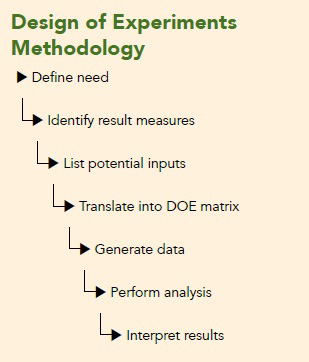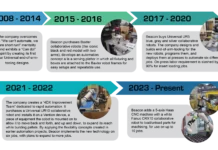by Perry Parendo, Perry’s Solutions, Inc.
After decades of working with multiple industries, I have found only one developmental tool that works when things are not going as expected. That tool is Design of Experiments (DOE). It is a statistically based tool that allows evaluation of simultaneous input variables and the impact they have on contradictory requirements.
When developing a new product, the customer wants to achieve a certain level of product performance. The manufacturer wants to have a certain level of production efficiency. The end user wants to have reliable performance in the field. All three groups want to accomplish these things within a reasonable budget and timeframe. DOE can find flaws that prevent the achievement of these goals.
How Does DOE Work?
DOE is a method that can simultaneously change input variables and extract their individual contributions to an output variable. While it is a mathematical tool, the keys to success lie with the non-math activities. The first step is to determine what needs to be learned. This tends to be a balance between performance objectives, and sometimes includes business needs (cost, as one example). Second, the measurements of the results that will indicate progress toward those needs must be determined. Multiple measurements are not uncommon for a real-life situation, though many textbooks will only show one. Next, determine the potential input variables that may influence those outputs. This is balanced with the available budget and schedule. Finally, these items are translated into a predefined matrix to allow extraction of the relationships desired. After the data is collected, a statistical analysis is performed to provide a mathematical model and to determine the learning obtained. Based on the findings, either a recommendation for change is made or further testing is required to obtain deeper learning. Any step may return to an earlier step if there is a contradiction that needs to be resolved. Let’s consider the DOE tools in a few different areas of use.
Performance Testing for Product and Process Design
First, let’s consider performance testing. This can include either product or process performance. To a degree, product and process design are similar. A product feature may require a new process. On the other hand, an incapable process could dictate a product change. Let’s give an example of both.
At one time, I was responsible for a battery design project. The company had an internal piece of software which could provide performance information based on high-level design inputs. Using our detailed CAD model, we could understand the design constraints that created the design space for this particular application. Using a DOE approach allowed us to understand the design (the sensitivities), so we knew where to tighten certain inputs to ensure we met a customer need. It also let us know where we could relax standards to create a more cost-effective product. However, other aspects of the design required empirical testing as they could not be predicted with current knowledge. Again, DOE was used to understand these aspects of the prototype hardware and fill out the design settings. This approach created a high level of confidence going into the final and successful verification testing.
On the process design side, a design and iterative perspective often is lacking. In one case, a fairly well-established ultrasonic welding process was being used for prototypes. However, it was not meeting the requirements – was it even the right process for these materials? Were we just using the recommended settings? Were we understanding what would work for this particular design? Opinions were mixed on what the issue was – an overly demanding requirement or a process not tuned properly. With a combination of two DOE tests, a balanced process was found, but it took us outside the traditionally acceptable operating range for these materials. The eventual process was confirmed and the parts accepted by the customer. Years later, the process continues to produce parts that meet the customer needs. This fact is a reflection of the discipline used during the early stages of the project.
Another example is from a coating application. A manufacturing facility was being refurbished. In parallel with the equipment installation, lab samples were coated. We wanted to apply enough thickness to be protective without overusing material. At the same time, we wanted to have an attractive finish on the product, which often requires thicker coatings. With the lab optimization, we were able to apply the process setting after the equipment was purchased and put into place. This created the best start-up ever when production was ramped up to full speed. We balanced the requirements of protection, appearance and material usage.
Product design is a great application of the DOE tools; however, it has historically not been a high percentage of use. I sometimes call these applications “doing your homework.” By developing an early understanding, surprises can be avoided downstream.
Manufacturing Applications: Production Efficiency
The next application area is production efficiency. This could be reflected as low yields, assuming that a level that made production a good business decision had previously been achieved. If a poor design (product and process design) was released to manufacturing, then the homework was not done.
There are two examples here for consideration. In the first, the process had previously been capable for a major client with a multi-million dollar product. Our failure to deliver was creating a huge and noticeable hole for them. We had a few ideas of what the issue could be, but if all ideas were implemented, it would increase production time and costs. How could we “quickly” evaluate them all? Using a DOE approach, we were able to confidently find the solution in an afternoon, and then communicate to the customer, with confidence, that the solution was going to be permanent. Luckily, the solution was a no cost and no effort addition. Often times, the process of problem-solving consumes weeks of deliberation, creating high doubt and dissatisfaction with the customer. Instead, we reacted within eight hours of the finding and were able to ship with an approved customer deviation.
The other example is from a process that was not known to be capable, but was already released to manufacturing. We had been “lucky” to have “nominal” conditions that allowed the product to pass the test. A short amount of DOE testing showed that the entire reasonable process window was not able to confidently provide an answer to the problem. This led to a change in the equipment set- up, and allowed for the change in performance. With DOE testing, we could create the confidence in this new solution, and move on to other situations instead of having to babysit this particular item.
Product Reliability and Availability
Finally, DOE can be applied to product reliability where there is concern about a product’s ability to perform in a variety of environmental conditions, such as high temperature, high humidity or a high UV exposure. Other concerns include aging or product wear over time, sensitivity to noise factors or electrical voltage and changes to system performance. As a category, this is sometimes called robust design.
To achieve true reliability takes a considerable amount of time. However, if we can find “indicator” measures of reliability, then we can accelerate the evaluation and testing. When working on the reliability of a wearable item, to determine the actual wear out time would take a very long time, even with accelerated testing methods. However, some simple prototypes can be created and measured with early indicator measures. For instance, we could measure the diameter or length of the critical parts. Maybe we could measure the surface finish of the parts, to see the beginning of deterioration. It could be that a weight measurement would be a good indication. Maybe a leak rate could be measured – either with a back-filled oil or gas environment. Another option could be acoustic measurements. Lack of change of these values, over a period of time, would provide indications of improved reliability, but over a much shorter duration than the full test. Picking the best combination of variables for this short-term test is expected to provide the best opportunity to pass the long-term test.
In Conclusion
If well-known principles are in place, a DOE approach still can help in understanding the sensitivities of the design. For instance, the sensitivities can be understood through use of a computer simulation. If the principles need to be determined, a DOE approach is certainly required. This approach works equally well for product and process design, though the traditional applications of the 75- year history of DOE has been to resolve manufacturing issues after product release. However, those situations could be avoided if addressed much earlier in product and process development in R&D. It is essential to get the homework done early to create a competitive advantage; thus, getting products to market at a much faster and more confident pace.
Perry’s Solutions is a consulting company offering new product design, program management and training services, specializing in using Design of Experiments software to improve products and solve problems for medical device companies and other manufacturers. Perry Parendo, president, can be reached via phone at 651.230.3861 or through his website, www.perryssolutions.com.





